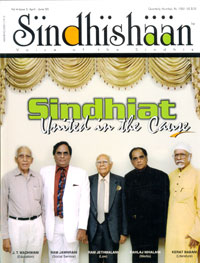SINDHI SHORT STORY GENRE
by - Sujul Haq Memon
In Sindh, it is often said that Sindhis are “Ghalhyun ja Gaheera”, which is meant to convey that the Sindhis make up stories and relate them to their friends and even to strangers. Those of you, who originally belong to Sindh, are well aware of the institution of Otaq, a place where friends and relatives from diverse places are accommodated for a short stay.
But it is considered impolite to leave the guests unattended. The host would visit them in the evenings and entertain them with music by some locals or for a lively tete-a-tete accompanied by the village “Hakeem” or a local story teller who would relate real or imaginary tales of adventure, romance or tribal conflicts. With the advent of writing, some of these stories were recorded as ‘Dastan’. A Dastan portrayed a single or multiple occurrences always resulting in a climax; - a war, a romance, a dacoity, a rescue, most often involving a woman, or merely an episode of the resistance of the peasantry against a tyrant land lord. The climax was always unexpected; sometimes even mysterious; and rarely a union of lovers. These Dastans, recorded in writing gave us the great romances of Shah Latif; Umar-Marui, Lila-Chanesar, Moomal Rano and even stories of seafarers, boatmen and fisherfolk.
These romances were the foundation and frame work of Sindhi short story. You will find most of the Sindhi short stories having a touch of Dastan-goee. What the modern short story writers have written and are writing in this genre, also reflects this kind of story telling; of course with a touch of embellishment or refinement under the influence of short stories from other languages. From Amarlal Hingorani to Amar Jalil to Shaukat Shoro one can see this ingredient quite vividly.
The other ingredient of Sindhi short story is the commitment to Sindhi language and its people. I am reminded of Sartre’s remark, that the writers are committed, because they think that words are action for a change. Every Sindhi short story writer, rightly or wrongly, considers that he is contributing towards bringing an era of peace and progress for the Sindhi people and I can say without any fear of contradiction that the Sindhi short indeed did so.
Sindhi literature was always fraught with the danger of annoying the establishment. I can tell you that quite a few of our short story writers were hauled up and taken to task. To give you a personal example, when one of my stories was published, we had visitors who wanted to know who was in my mind when I penned my story. Since I was then a government servant, I was really given a hard time. So was the case with Amar Jalil, Ali Baba and many others.
The third element in Sindhi short story is the influence of Marxism as a philosophy. This is a unique phenomenon that a campaign started against Sindhi short stories in some of the rightist papers dubbing Sindhi writers as not only Marxists but infidels too. Some newspapers even called us ‘Bey Deen’ and other equally provocative terms. I have so far avoided taking names, except a few. This I have done deliberately, because I do not wish to create a controversy back in Sindh that I have taken the names of only those who belong to our group and left out those who are perhaps greater short story writers. Such controversy is the hallmark of the Sindhi literary scene in Sindh. I therefore pray for your forgiveness for this omission.
Sindhi short story has reached a stage where I feel that after the climax, an anticlimax and a fall has started both in India and in Pakistan. Recently published stories lack that earlier excellence. Or perhaps my judgement is clouded because these days our own concern is more on writing the story of Sindhi language and its development, which is a full time job.


